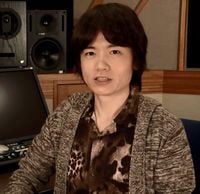Masahiro Sakurai: Difference between revisions
mNo edit summary |
Ninelevendo (talk | contribs) |
||
| Line 2: | Line 2: | ||
{{LLQuote|It was tough for me to see that every time I made a new game, people automatically assumed that a sequel was coming. Even if it's a sequel, lots of people have to give their all to make a game, but some people think the sequel process happens naturally.|[[Masahiro Sakurai]]|[http://www.nindori.com Nintendo Dream], August 26, 2003}} | {{LLQuote|It was tough for me to see that every time I made a new game, people automatically assumed that a sequel was coming. Even if it's a sequel, lots of people have to give their all to make a game, but some people think the sequel process happens naturally.|[[Masahiro Sakurai]]|[http://www.nindori.com Nintendo Dream], August 26, 2003}} | ||
'''Masahiro Sakurai''' ( | '''Masahiro Sakurai''' (in Japanese: 桜井 政博) is a Japanese video game director and former [[HAL Laboratory]] employee. He is best known for his creation of the ''[[wikirby:Kirby (series)|Kirby]]'' and ''[[Super Smash Bros. (series)|Super Smash Bros.]]'' series. [[Nintendo]]'s HAL Laboratory hired Masahiro when he was nineteen years old in 1991.<ref name="Nsider">[http://www.n-sider.com/personnelview.php?personnelid=982 N-Sider Media: Masahiro Sakurai Personnel Profile]. Accessed 1-23-08.</ref> In 2003, he left Hal Laboratory to pursue a career in freelance game design. | ||
==Original Employment by Nintendo== | ==Original Employment by Nintendo== | ||
Revision as of 01:29, June 22, 2014
Masahiro Sakurai (in Japanese: 桜井 政博) is a Japanese video game director and former HAL Laboratory employee. He is best known for his creation of the Kirby and Super Smash Bros. series. Nintendo's HAL Laboratory hired Masahiro when he was nineteen years old in 1991.[1] In 2003, he left Hal Laboratory to pursue a career in freelance game design.
Original Employment by Nintendo
In 1991, Masahiro was hired by HAL Laboratory. A year later, he created and directed his first title, Kirby's Dream Land, a title that is considered to be Sakurai's breakthrough, using his character Kirby as the protagonist.[1] Eventually, he and Satoru Iwata, who was still an employee of HAL at the time, worked together to create the original Super Smash Bros. title, using Nintendo characters. After the success of this game, Sakurai was asked to develop its sequel, Super Smash Bros. Melee.[2]
After completing this title and Kirby Air Ride, Masahiro left Nintendo on August 5, 2003, later citing Nintendo's desire for sequels as the reason for his departure. He had grown tired of being asked to create the next Kirby or Super Smash Bros. title and longed to have more creative freedom. He later coined the term, "sequelization" to describe the problem he saw not only within Nintendo, but throughout the video game industry.[3] (Ironically, despite how he left because he wanted to try other projects, he has still wound up working on more Super Smash Bros. installments.)
Continued Involvement
After leaving HAL Laboratory, Sakurai created Sora Ltd.. He stated that the reason he became a freelance game developer was that he felt bogged down by working with the same people with the same characters.[3]
At E3 2005, Iwata, now president of Nintendo, revealed that his company was planning a new Super Smash Bros. title which was later named Super Smash Bros. Brawl. According to Iwata, the press read too far into this announcement, going so far as to ask Masahiro if he would develop the title. Masahiro was shocked, but Iwata invited his former employee to his hotel room to clarify the situation. Satoru said that he expected the new Super Smash Bros. to be a port of Super Smash Bros. Melee with added Nintendo Wi-Fi Connection features unless Masahiro would be involved. Sakurai later admitted that this served as a kind of threat to him. However, Sakurai had come to E3 looking for new ideas, so he decided to take the opportunity.[4]
However, the traditional Super Smash Bros. team at HAL Laboratory was currently working on another project. Sakurai and Iwata decided that the best location for the project would be in Tokyo, specifically, Takadanobaba. Sakurai moved there for the project. The development team, part of "Game Arts", was introduced to Masahiro by Shigeru Miyamoto.[5] Sakurai and his team of one hundred, also known as "The Studio," worked on the project, delaying it as necessary, until it was released in Japan on January 31, 2008.[6] In addition to directing the title, Masahiro Sakurai also voiced King Dedede, one of the playable characters in the game.[7] Masahiro has not commented on his future with Nintendo.
At E3 2011, Iwata revealed that a new Super Smash Bros. game will be developed for both the Nintendo 3DS and Wii U[8], but the game will not begin development until Kid Icarus: Uprising, Sakurai's then-current project, is completed. It was also announced on June 2012 that Namco Bandai will be co-developing the game alongside Sora Ltd..[9]
Trivia
- Masahiro Sakurai created a microgame named Line Slash with WarioWare: D.I.Y.. It was made available for download in the "Big Name Games" category in Japan on May 27, 2009 and in other regions in 2010. The game has not yet been taken off and is still available for download, unlike most other games developed by celebrities. A video of Sakurai developing his microgame is available in original Japanese and with English subtitles.
References
- ^ a b N-Sider Media: Masahiro Sakurai Personnel Profile. Accessed 1-23-08.
- ^ Iwata Asks: Super Smash Bros. Brawl Vol.1, pg. 1. Accessed 1-23-08.
- ^ a b Nintendo Dream August 26, 2003.
- ^ Iwata Asks: Super Smash Bros. Brawl Vol.1, pg. 2. Accessed 1-23-08.
- ^ Iwata Asks: Super Smash Bros. Brawl Vol.1, pg. 3. Accessed 1-23-08.
- ^ IGN Wii Super Smash Bros. Brawl Game Profile. Accessed 1-23-08
- ^ Masahiro Sakurai. Smash Trivia. Smash Bros. DOJO!! (American English). Accessed 4-15-08.
- ^ Gamestop - E3 2011: New Super Smash Bros. game in development
- ^ IGN: Namco Bandai Developing Next Smash Bros.
